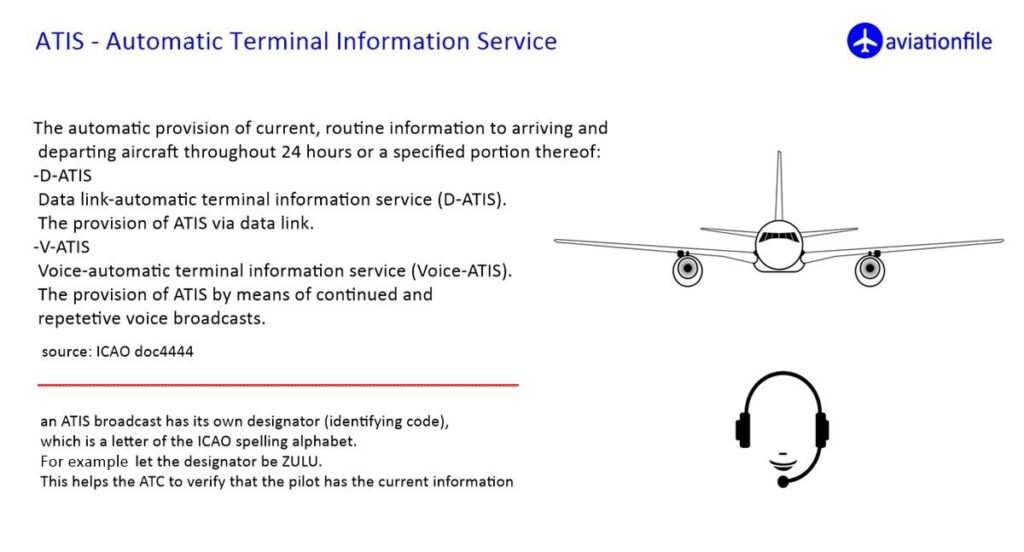What is ATIS (Automatic Terminal Information Service)?
Ever wondered how pilots navigate complex airport environments with constant traffic? One key tool in their arsenal is the Automatic Terminal Information Service (ATIS). Let’s take a deep dive into what ATIS is, the information it provides, and how pilots utilize it for a smoother and safer flying experience.
What is ATIS?
ATIS is a continuous broadcast of pre-recorded or synthesized voice messages containing critical aeronautical information for a specific airport or terminal area. It operates 24/7 at busy airports, automatically updating with the latest weather, runway conditions, and other pertinent details.
ATIS — D-ATIS & Voice ATIS
There are two types of ATIS broadcast: D-ATIS (Data Link-Automatic Terminal Information Services) and Voice-ATIS. Both must be published in the same content and format. With Voice-ATIS, the pilot listens to the voice broadcast in the cockpit and takes notes. However, many aircraft now use D-ATIS. The system, integrated into the FMS, guarantees that all information is printed out. The pilot does not need to listen to the broadcast one by one as in Voice ATIS, and the ability to print out with D-ATIS reduces the workload of the pilots. In order to use D-ATIS, the ground station must also have the equipment that can provide this broadcast.
Benefits of Using ATIS
ATIS serves a multitude of purposes, benefitting both pilots and air traffic controllers:
- Reduced Pilot Workload: By receiving essential information upfront, pilots can focus on critical flying tasks rather than repeatedly requesting updates from air traffic control.
- Improved Efficiency: ATIS frees up valuable air traffic control (ATC) communication channels, allowing controllers to manage traffic flow more effectively.
- Enhanced Safety: Timely dissemination of accurate airport information fosters safer flight operations for all involved.
Atis Structure and Update
The ATIS record is updated regularly or whenever there is a significant change. Each ATIS broadcast is allocated a letter starting from A and takes its name from the alphabet, respectively. Each new ATIS message is named with the next letter of the alphabet. Thus, when an air traffic control (ATC) unit notifies its current ATIS code, the air traffic controller knows whether the pilot’s information is up to date. In this case, pilots report on their first contact with air traffic controllers whether they have ATIS information.
If ATIS is not received by the pilot or if the pilot has incorrect ATIS information, air traffic units can transmit ATIS information to pilots under the name of “departure information” or “landing information”. Pilots should listen ATIS broadcast before the first contact as much as possible to reduce the workload on air traffic units. For example, if pilots say ‘Information A copied’ on their first contact, but if the new ATIS B is published just before the contact, the relevant air traffic unit will provide up-to-date ATIS information or the pilot may be advised to take / listen to the new broadcast.
Whenever possible, broadcast ATIS on a separate VHF frequencies. And should not interfere with other navigation equipment. It is broadcast in English for international aviation services at airports, broadcasts are suitable for more than one language, and separate channels are used for each language to be used.
Content of ATIS
The contents of ATIS publications may contain all or some of the following information:
- Name of aerodrome;
- Arrival and/or departure indicator;
- Contract type, if communication is via D-ATIS;
- Runway designator;
- Time of observation, if appropriate;
- Type of approach(es) to be expected;
- The runway(s) in use; status of arresting system constituting a potential hazard, if any;
- Significant runway surface conditions and, if appropriate, braking action;
- Holding delay, if appropriate;
- Transition level, if applicable;
- Other essential operational information;
- Surface wind direction (in degrees magnetic) and speed, including significant variations and, if surface wind sensors related specifically to the sections of runway(s) in use are available and the information is required by operators, the indication of the runway and the section of the runway to which the information refers;
- Visibility and, when applicable, RVR;
- Present weather;
- Cloud below 1 500 m (5 000 ft) or below the highest minimum sector altitude, whichever is greater; cumulonimbus; if the sky is obscured, vertical visibility when available;
- Air temperature;
- Dew point temperature;
- Altimeter setting(s);
- Any available information on significant meteorological phenomena in the approach and climb-out areas including wind shear, and information on recent weather of operational significance;
- Trend forecast, when available; and
- Specific ATIS instructions.
Source of ATIS content: skybrary.aero

References and Further Reading for ATIS
- Federal Aviation Administration (FAA): Automatic Terminal Information Service Procedures https://www.faa.gov/
- SKYbrary Aviation Safety: Automatic Terminal Information Service (ATIS) | https://skybrary.aero/
- Wikipedia: Automatic terminal information service https://en.wikipedia.org/wiki/ATIS
For more articles click.


